COIT20261- Network Routing and Switching
VerifiedAdded on 2021/05/31
|8
|2446
|48
AI Summary
Contribute Materials
Your contribution can guide someone’s learning journey. Share your
documents today.
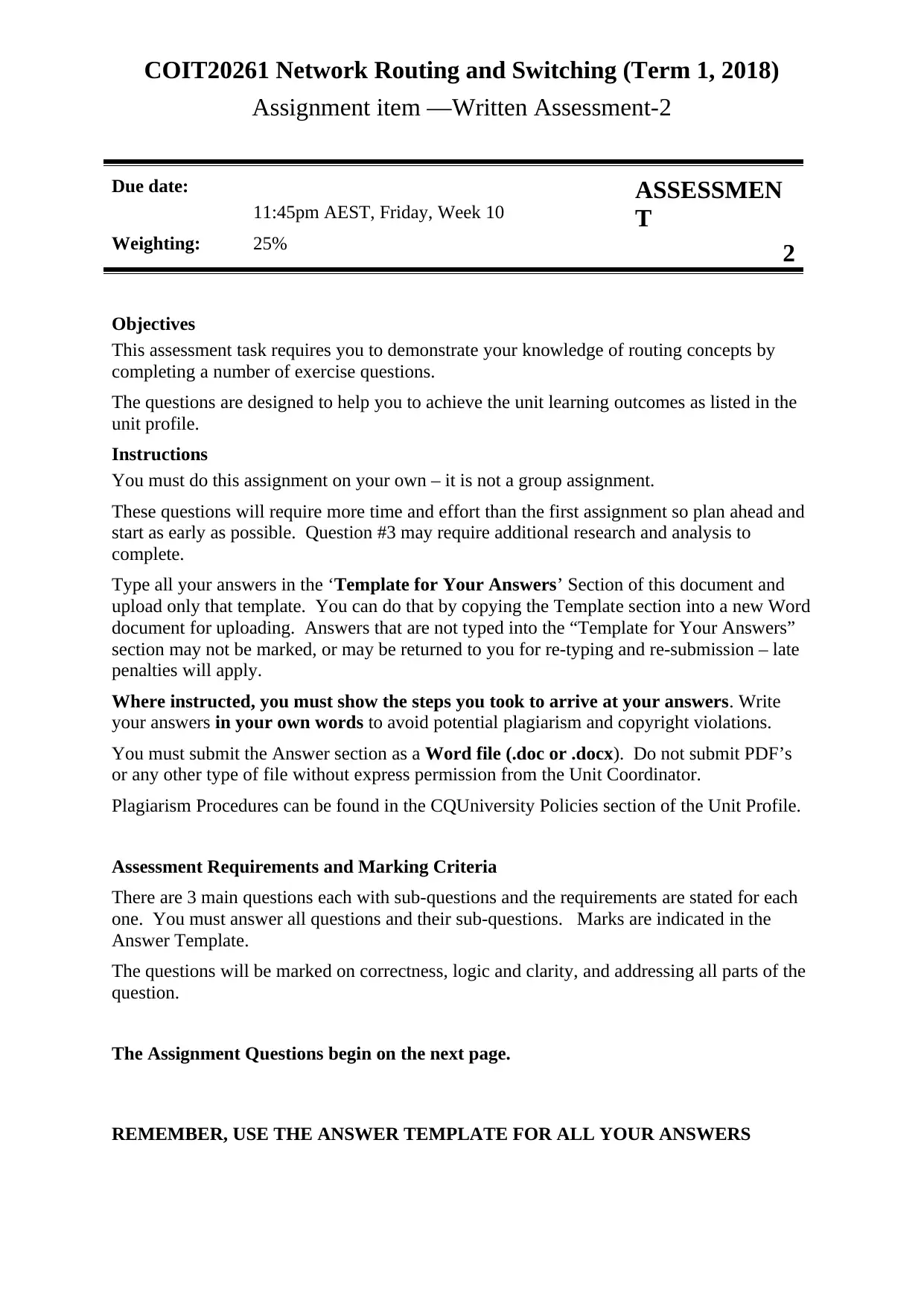
COIT20261 Network Routing and Switching (Term 1, 2018)
Assignment item —Written Assessment-2
Due date:
11:45pm AEST, Friday, Week 10
ASSESSMEN
T
Weighting: 25% 2
Objectives
This assessment task requires you to demonstrate your knowledge of routing concepts by
completing a number of exercise questions.
The questions are designed to help you to achieve the unit learning outcomes as listed in the
unit profile.
Instructions
You must do this assignment on your own – it is not a group assignment.
These questions will require more time and effort than the first assignment so plan ahead and
start as early as possible. Question #3 may require additional research and analysis to
complete.
Type all your answers in the ‘Template for Your Answers’ Section of this document and
upload only that template. You can do that by copying the Template section into a new Word
document for uploading. Answers that are not typed into the “Template for Your Answers”
section may not be marked, or may be returned to you for re-typing and re-submission – late
penalties will apply.
Where instructed, you must show the steps you took to arrive at your answers. Write
your answers in your own words to avoid potential plagiarism and copyright violations.
You must submit the Answer section as a Word file (.doc or .docx). Do not submit PDF’s
or any other type of file without express permission from the Unit Coordinator.
Plagiarism Procedures can be found in the CQUniversity Policies section of the Unit Profile.
Assessment Requirements and Marking Criteria
There are 3 main questions each with sub-questions and the requirements are stated for each
one. You must answer all questions and their sub-questions. Marks are indicated in the
Answer Template.
The questions will be marked on correctness, logic and clarity, and addressing all parts of the
question.
The Assignment Questions begin on the next page.
REMEMBER, USE THE ANSWER TEMPLATE FOR ALL YOUR ANSWERS
Assignment item —Written Assessment-2
Due date:
11:45pm AEST, Friday, Week 10
ASSESSMEN
T
Weighting: 25% 2
Objectives
This assessment task requires you to demonstrate your knowledge of routing concepts by
completing a number of exercise questions.
The questions are designed to help you to achieve the unit learning outcomes as listed in the
unit profile.
Instructions
You must do this assignment on your own – it is not a group assignment.
These questions will require more time and effort than the first assignment so plan ahead and
start as early as possible. Question #3 may require additional research and analysis to
complete.
Type all your answers in the ‘Template for Your Answers’ Section of this document and
upload only that template. You can do that by copying the Template section into a new Word
document for uploading. Answers that are not typed into the “Template for Your Answers”
section may not be marked, or may be returned to you for re-typing and re-submission – late
penalties will apply.
Where instructed, you must show the steps you took to arrive at your answers. Write
your answers in your own words to avoid potential plagiarism and copyright violations.
You must submit the Answer section as a Word file (.doc or .docx). Do not submit PDF’s
or any other type of file without express permission from the Unit Coordinator.
Plagiarism Procedures can be found in the CQUniversity Policies section of the Unit Profile.
Assessment Requirements and Marking Criteria
There are 3 main questions each with sub-questions and the requirements are stated for each
one. You must answer all questions and their sub-questions. Marks are indicated in the
Answer Template.
The questions will be marked on correctness, logic and clarity, and addressing all parts of the
question.
The Assignment Questions begin on the next page.
REMEMBER, USE THE ANSWER TEMPLATE FOR ALL YOUR ANSWERS
Secure Best Marks with AI Grader
Need help grading? Try our AI Grader for instant feedback on your assignments.
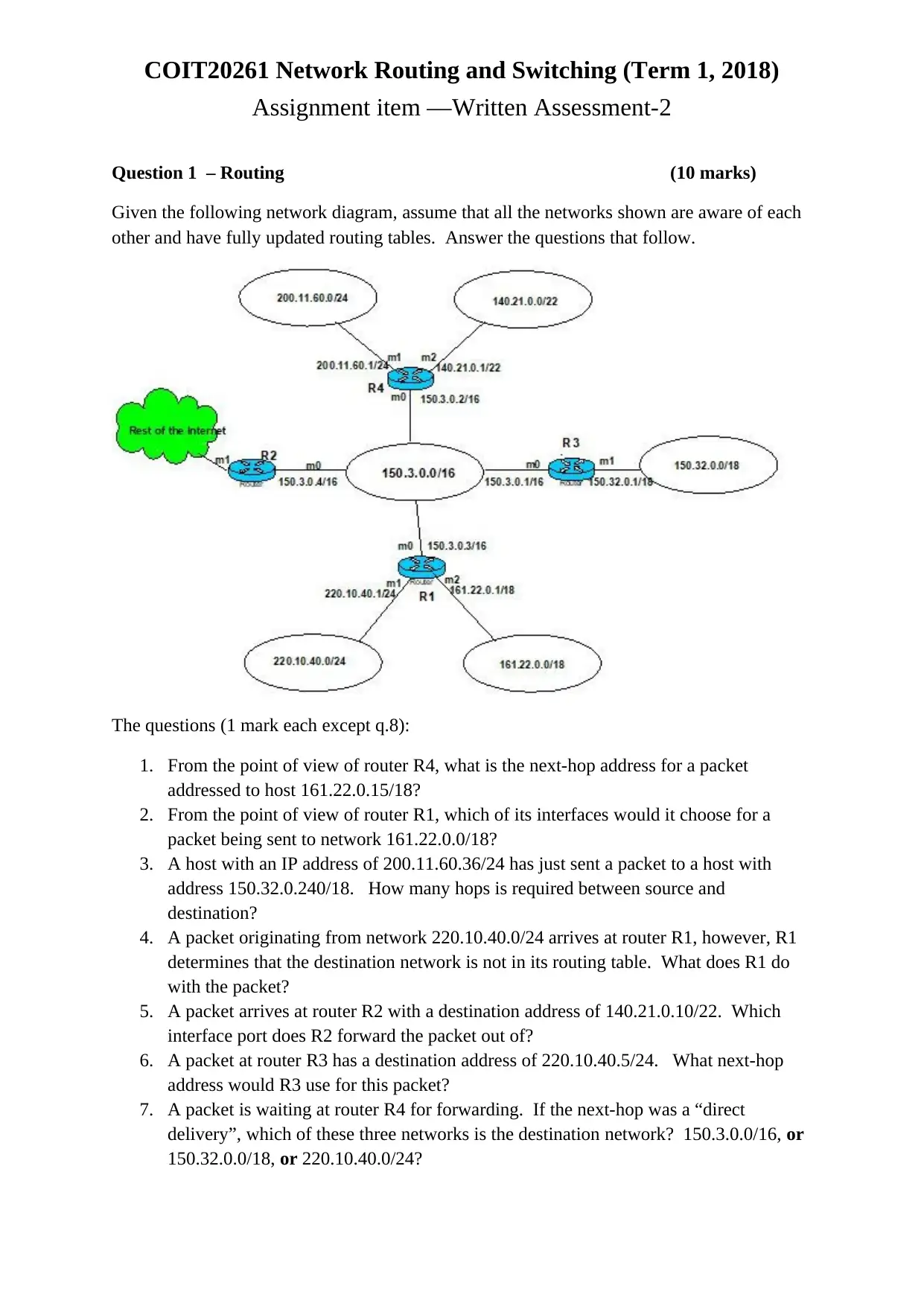
COIT20261 Network Routing and Switching (Term 1, 2018)
Assignment item —Written Assessment-2
Question 1 – Routing (10 marks)
Given the following network diagram, assume that all the networks shown are aware of each
other and have fully updated routing tables. Answer the questions that follow.
The questions (1 mark each except q.8):
1. From the point of view of router R4, what is the next-hop address for a packet
addressed to host 161.22.0.15/18?
2. From the point of view of router R1, which of its interfaces would it choose for a
packet being sent to network 161.22.0.0/18?
3. A host with an IP address of 200.11.60.36/24 has just sent a packet to a host with
address 150.32.0.240/18. How many hops is required between source and
destination?
4. A packet originating from network 220.10.40.0/24 arrives at router R1, however, R1
determines that the destination network is not in its routing table. What does R1 do
with the packet?
5. A packet arrives at router R2 with a destination address of 140.21.0.10/22. Which
interface port does R2 forward the packet out of?
6. A packet at router R3 has a destination address of 220.10.40.5/24. What next-hop
address would R3 use for this packet?
7. A packet is waiting at router R4 for forwarding. If the next-hop was a “direct
delivery”, which of these three networks is the destination network? 150.3.0.0/16, or
150.32.0.0/18, or 220.10.40.0/24?
Assignment item —Written Assessment-2
Question 1 – Routing (10 marks)
Given the following network diagram, assume that all the networks shown are aware of each
other and have fully updated routing tables. Answer the questions that follow.
The questions (1 mark each except q.8):
1. From the point of view of router R4, what is the next-hop address for a packet
addressed to host 161.22.0.15/18?
2. From the point of view of router R1, which of its interfaces would it choose for a
packet being sent to network 161.22.0.0/18?
3. A host with an IP address of 200.11.60.36/24 has just sent a packet to a host with
address 150.32.0.240/18. How many hops is required between source and
destination?
4. A packet originating from network 220.10.40.0/24 arrives at router R1, however, R1
determines that the destination network is not in its routing table. What does R1 do
with the packet?
5. A packet arrives at router R2 with a destination address of 140.21.0.10/22. Which
interface port does R2 forward the packet out of?
6. A packet at router R3 has a destination address of 220.10.40.5/24. What next-hop
address would R3 use for this packet?
7. A packet is waiting at router R4 for forwarding. If the next-hop was a “direct
delivery”, which of these three networks is the destination network? 150.3.0.0/16, or
150.32.0.0/18, or 220.10.40.0/24?
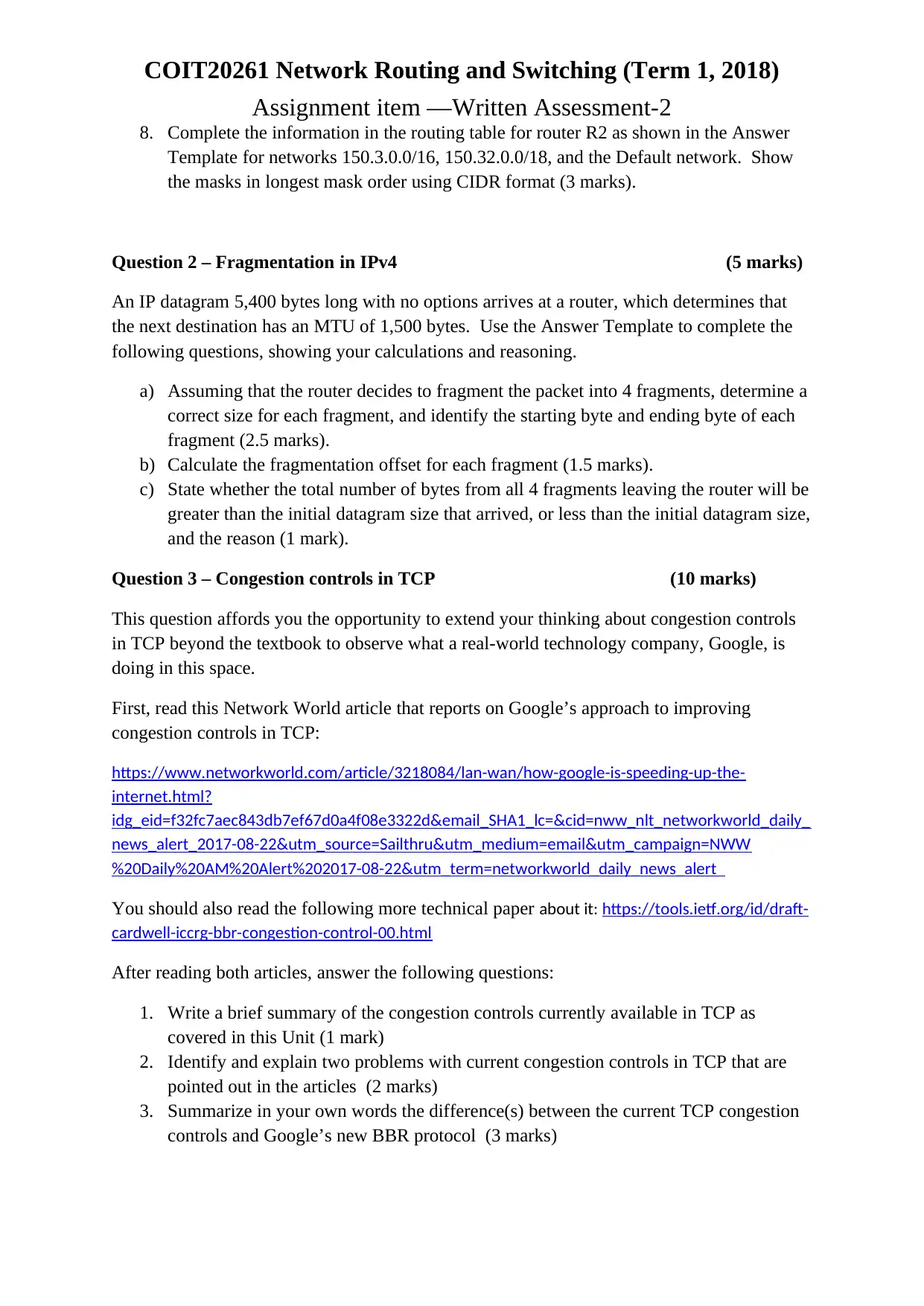
COIT20261 Network Routing and Switching (Term 1, 2018)
Assignment item —Written Assessment-2
8. Complete the information in the routing table for router R2 as shown in the Answer
Template for networks 150.3.0.0/16, 150.32.0.0/18, and the Default network. Show
the masks in longest mask order using CIDR format (3 marks).
Question 2 – Fragmentation in IPv4 (5 marks)
An IP datagram 5,400 bytes long with no options arrives at a router, which determines that
the next destination has an MTU of 1,500 bytes. Use the Answer Template to complete the
following questions, showing your calculations and reasoning.
a) Assuming that the router decides to fragment the packet into 4 fragments, determine a
correct size for each fragment, and identify the starting byte and ending byte of each
fragment (2.5 marks).
b) Calculate the fragmentation offset for each fragment (1.5 marks).
c) State whether the total number of bytes from all 4 fragments leaving the router will be
greater than the initial datagram size that arrived, or less than the initial datagram size,
and the reason (1 mark).
Question 3 – Congestion controls in TCP (10 marks)
This question affords you the opportunity to extend your thinking about congestion controls
in TCP beyond the textbook to observe what a real-world technology company, Google, is
doing in this space.
First, read this Network World article that reports on Google’s approach to improving
congestion controls in TCP:
https://www.networkworld.com/article/3218084/lan-wan/how-google-is-speeding-up-the-
internet.html?
idg_eid=f32fc7aec843db7ef67d0a4f08e3322d&email_SHA1_lc=&cid=nww_nlt_networkworld_daily_
news_alert_2017-08-22&utm_source=Sailthru&utm_medium=email&utm_campaign=NWW
%20Daily%20AM%20Alert%202017-08-22&utm_term=networkworld_daily_news_alert
You should also read the following more technical paper about it: https://tools.ietf.org/id/draft-
cardwell-iccrg-bbr-congestion-control-00.html
After reading both articles, answer the following questions:
1. Write a brief summary of the congestion controls currently available in TCP as
covered in this Unit (1 mark)
2. Identify and explain two problems with current congestion controls in TCP that are
pointed out in the articles (2 marks)
3. Summarize in your own words the difference(s) between the current TCP congestion
controls and Google’s new BBR protocol (3 marks)
Assignment item —Written Assessment-2
8. Complete the information in the routing table for router R2 as shown in the Answer
Template for networks 150.3.0.0/16, 150.32.0.0/18, and the Default network. Show
the masks in longest mask order using CIDR format (3 marks).
Question 2 – Fragmentation in IPv4 (5 marks)
An IP datagram 5,400 bytes long with no options arrives at a router, which determines that
the next destination has an MTU of 1,500 bytes. Use the Answer Template to complete the
following questions, showing your calculations and reasoning.
a) Assuming that the router decides to fragment the packet into 4 fragments, determine a
correct size for each fragment, and identify the starting byte and ending byte of each
fragment (2.5 marks).
b) Calculate the fragmentation offset for each fragment (1.5 marks).
c) State whether the total number of bytes from all 4 fragments leaving the router will be
greater than the initial datagram size that arrived, or less than the initial datagram size,
and the reason (1 mark).
Question 3 – Congestion controls in TCP (10 marks)
This question affords you the opportunity to extend your thinking about congestion controls
in TCP beyond the textbook to observe what a real-world technology company, Google, is
doing in this space.
First, read this Network World article that reports on Google’s approach to improving
congestion controls in TCP:
https://www.networkworld.com/article/3218084/lan-wan/how-google-is-speeding-up-the-
internet.html?
idg_eid=f32fc7aec843db7ef67d0a4f08e3322d&email_SHA1_lc=&cid=nww_nlt_networkworld_daily_
news_alert_2017-08-22&utm_source=Sailthru&utm_medium=email&utm_campaign=NWW
%20Daily%20AM%20Alert%202017-08-22&utm_term=networkworld_daily_news_alert
You should also read the following more technical paper about it: https://tools.ietf.org/id/draft-
cardwell-iccrg-bbr-congestion-control-00.html
After reading both articles, answer the following questions:
1. Write a brief summary of the congestion controls currently available in TCP as
covered in this Unit (1 mark)
2. Identify and explain two problems with current congestion controls in TCP that are
pointed out in the articles (2 marks)
3. Summarize in your own words the difference(s) between the current TCP congestion
controls and Google’s new BBR protocol (3 marks)
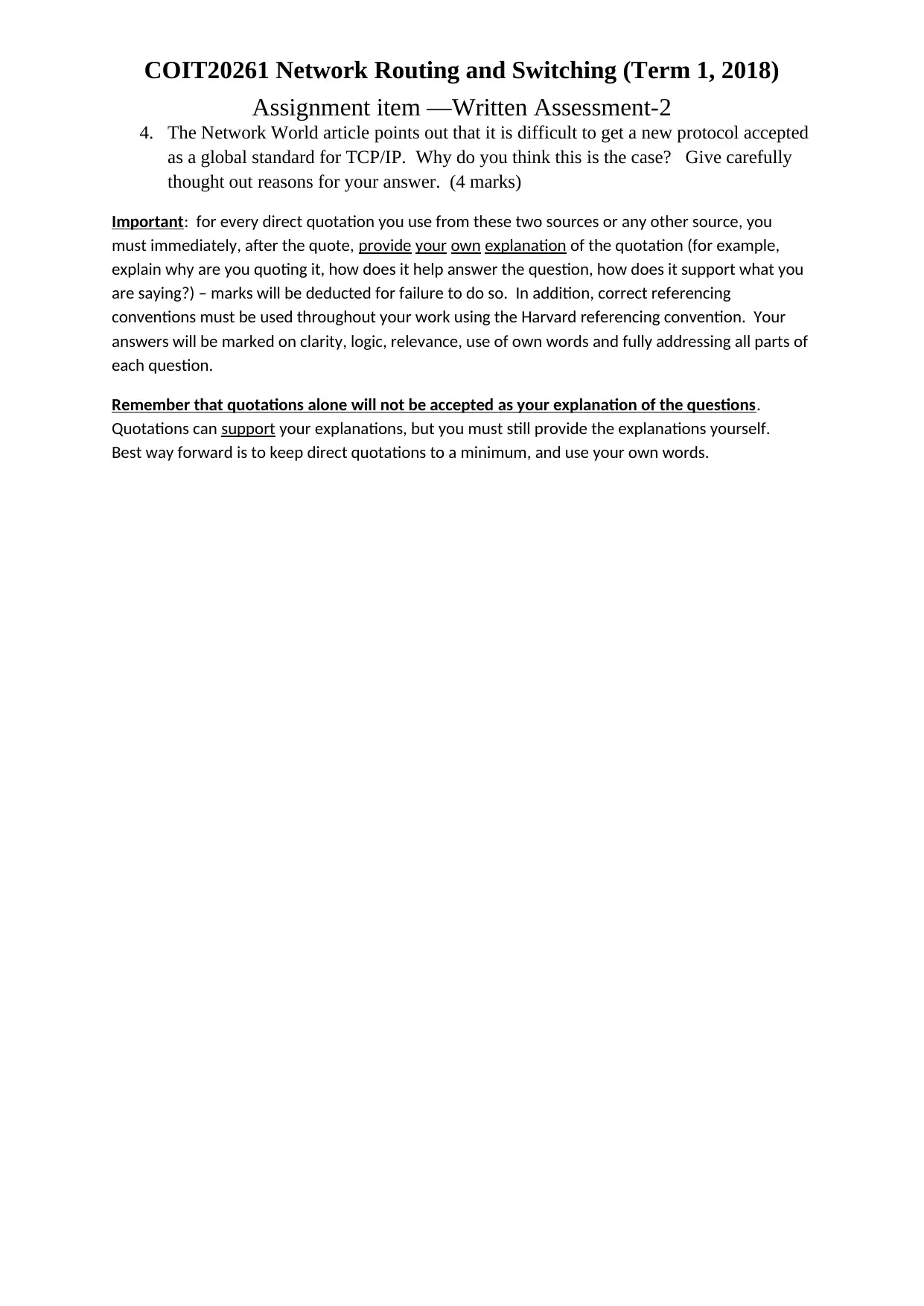
COIT20261 Network Routing and Switching (Term 1, 2018)
Assignment item —Written Assessment-2
4. The Network World article points out that it is difficult to get a new protocol accepted
as a global standard for TCP/IP. Why do you think this is the case? Give carefully
thought out reasons for your answer. (4 marks)
Important: for every direct quotation you use from these two sources or any other source, you
must immediately, after the quote, provide your own explanation of the quotation (for example,
explain why are you quoting it, how does it help answer the question, how does it support what you
are saying?) – marks will be deducted for failure to do so. In addition, correct referencing
conventions must be used throughout your work using the Harvard referencing convention. Your
answers will be marked on clarity, logic, relevance, use of own words and fully addressing all parts of
each question.
Remember that quotations alone will not be accepted as your explanation of the questions.
Quotations can support your explanations, but you must still provide the explanations yourself.
Best way forward is to keep direct quotations to a minimum, and use your own words.
Assignment item —Written Assessment-2
4. The Network World article points out that it is difficult to get a new protocol accepted
as a global standard for TCP/IP. Why do you think this is the case? Give carefully
thought out reasons for your answer. (4 marks)
Important: for every direct quotation you use from these two sources or any other source, you
must immediately, after the quote, provide your own explanation of the quotation (for example,
explain why are you quoting it, how does it help answer the question, how does it support what you
are saying?) – marks will be deducted for failure to do so. In addition, correct referencing
conventions must be used throughout your work using the Harvard referencing convention. Your
answers will be marked on clarity, logic, relevance, use of own words and fully addressing all parts of
each question.
Remember that quotations alone will not be accepted as your explanation of the questions.
Quotations can support your explanations, but you must still provide the explanations yourself.
Best way forward is to keep direct quotations to a minimum, and use your own words.
Secure Best Marks with AI Grader
Need help grading? Try our AI Grader for instant feedback on your assignments.
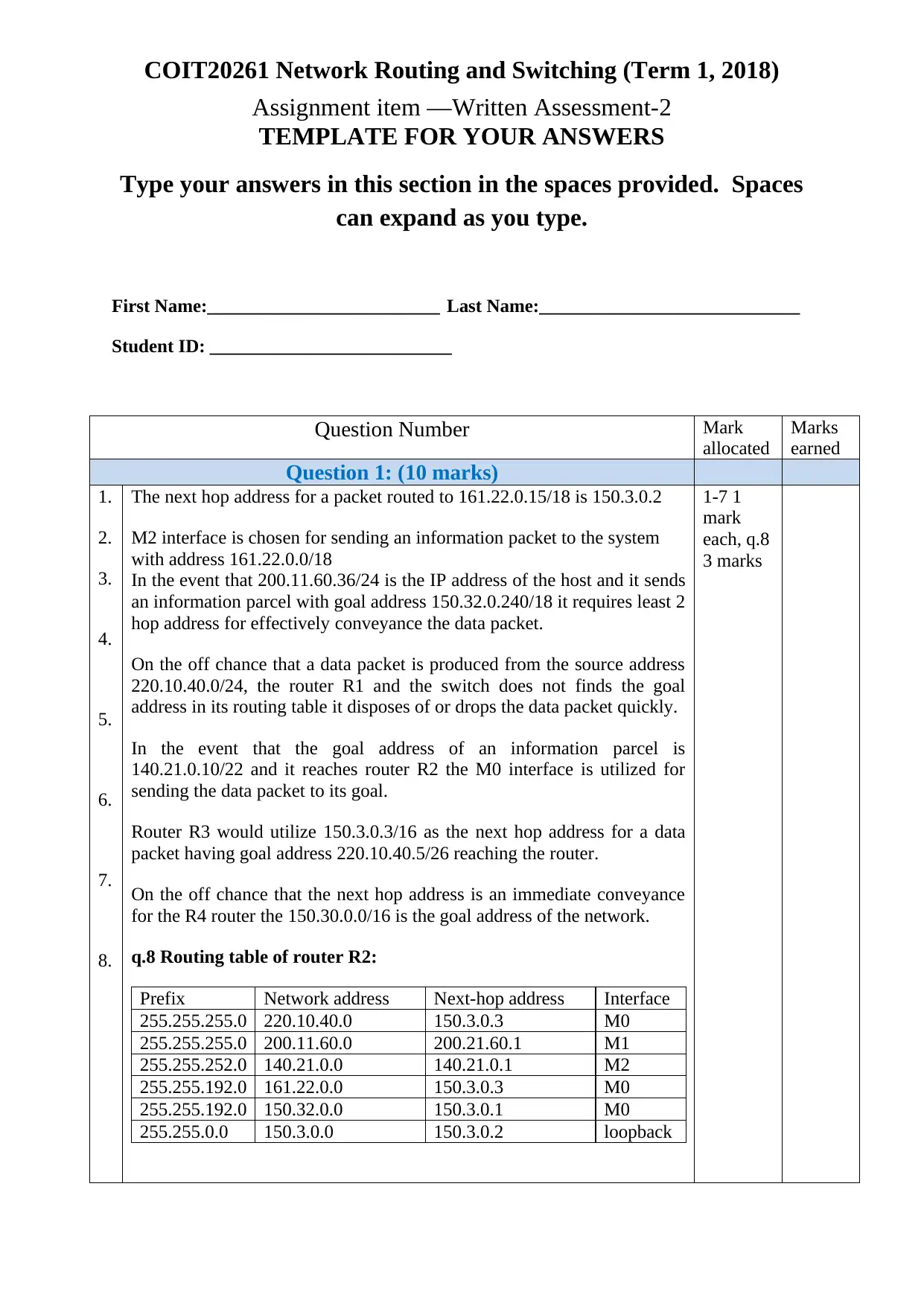
COIT20261 Network Routing and Switching (Term 1, 2018)
Assignment item —Written Assessment-2
TEMPLATE FOR YOUR ANSWERS
Type your answers in this section in the spaces provided. Spaces
can expand as you type.
First Name:_________________________ Last Name:____________________________
Student ID: __________________________
Question Number Mark
allocated
Marks
earned
Question 1: (10 marks)
1.
2.
3.
4.
5.
6.
7.
8.
The next hop address for a packet routed to 161.22.0.15/18 is 150.3.0.2
M2 interface is chosen for sending an information packet to the system
with address 161.22.0.0/18
In the event that 200.11.60.36/24 is the IP address of the host and it sends
an information parcel with goal address 150.32.0.240/18 it requires least 2
hop address for effectively conveyance the data packet.
On the off chance that a data packet is produced from the source address
220.10.40.0/24, the router R1 and the switch does not finds the goal
address in its routing table it disposes of or drops the data packet quickly.
In the event that the goal address of an information parcel is
140.21.0.10/22 and it reaches router R2 the M0 interface is utilized for
sending the data packet to its goal.
Router R3 would utilize 150.3.0.3/16 as the next hop address for a data
packet having goal address 220.10.40.5/26 reaching the router.
On the off chance that the next hop address is an immediate conveyance
for the R4 router the 150.30.0.0/16 is the goal address of the network.
q.8 Routing table of router R2:
Prefix Network address Next-hop address Interface
255.255.255.0 220.10.40.0 150.3.0.3 M0
255.255.255.0 200.11.60.0 200.21.60.1 M1
255.255.252.0 140.21.0.0 140.21.0.1 M2
255.255.192.0 161.22.0.0 150.3.0.3 M0
255.255.192.0 150.32.0.0 150.3.0.1 M0
255.255.0.0 150.3.0.0 150.3.0.2 loopback
1-7 1
mark
each, q.8
3 marks
Assignment item —Written Assessment-2
TEMPLATE FOR YOUR ANSWERS
Type your answers in this section in the spaces provided. Spaces
can expand as you type.
First Name:_________________________ Last Name:____________________________
Student ID: __________________________
Question Number Mark
allocated
Marks
earned
Question 1: (10 marks)
1.
2.
3.
4.
5.
6.
7.
8.
The next hop address for a packet routed to 161.22.0.15/18 is 150.3.0.2
M2 interface is chosen for sending an information packet to the system
with address 161.22.0.0/18
In the event that 200.11.60.36/24 is the IP address of the host and it sends
an information parcel with goal address 150.32.0.240/18 it requires least 2
hop address for effectively conveyance the data packet.
On the off chance that a data packet is produced from the source address
220.10.40.0/24, the router R1 and the switch does not finds the goal
address in its routing table it disposes of or drops the data packet quickly.
In the event that the goal address of an information parcel is
140.21.0.10/22 and it reaches router R2 the M0 interface is utilized for
sending the data packet to its goal.
Router R3 would utilize 150.3.0.3/16 as the next hop address for a data
packet having goal address 220.10.40.5/26 reaching the router.
On the off chance that the next hop address is an immediate conveyance
for the R4 router the 150.30.0.0/16 is the goal address of the network.
q.8 Routing table of router R2:
Prefix Network address Next-hop address Interface
255.255.255.0 220.10.40.0 150.3.0.3 M0
255.255.255.0 200.11.60.0 200.21.60.1 M1
255.255.252.0 140.21.0.0 140.21.0.1 M2
255.255.192.0 161.22.0.0 150.3.0.3 M0
255.255.192.0 150.32.0.0 150.3.0.1 M0
255.255.0.0 150.3.0.0 150.3.0.2 loopback
1-7 1
mark
each, q.8
3 marks
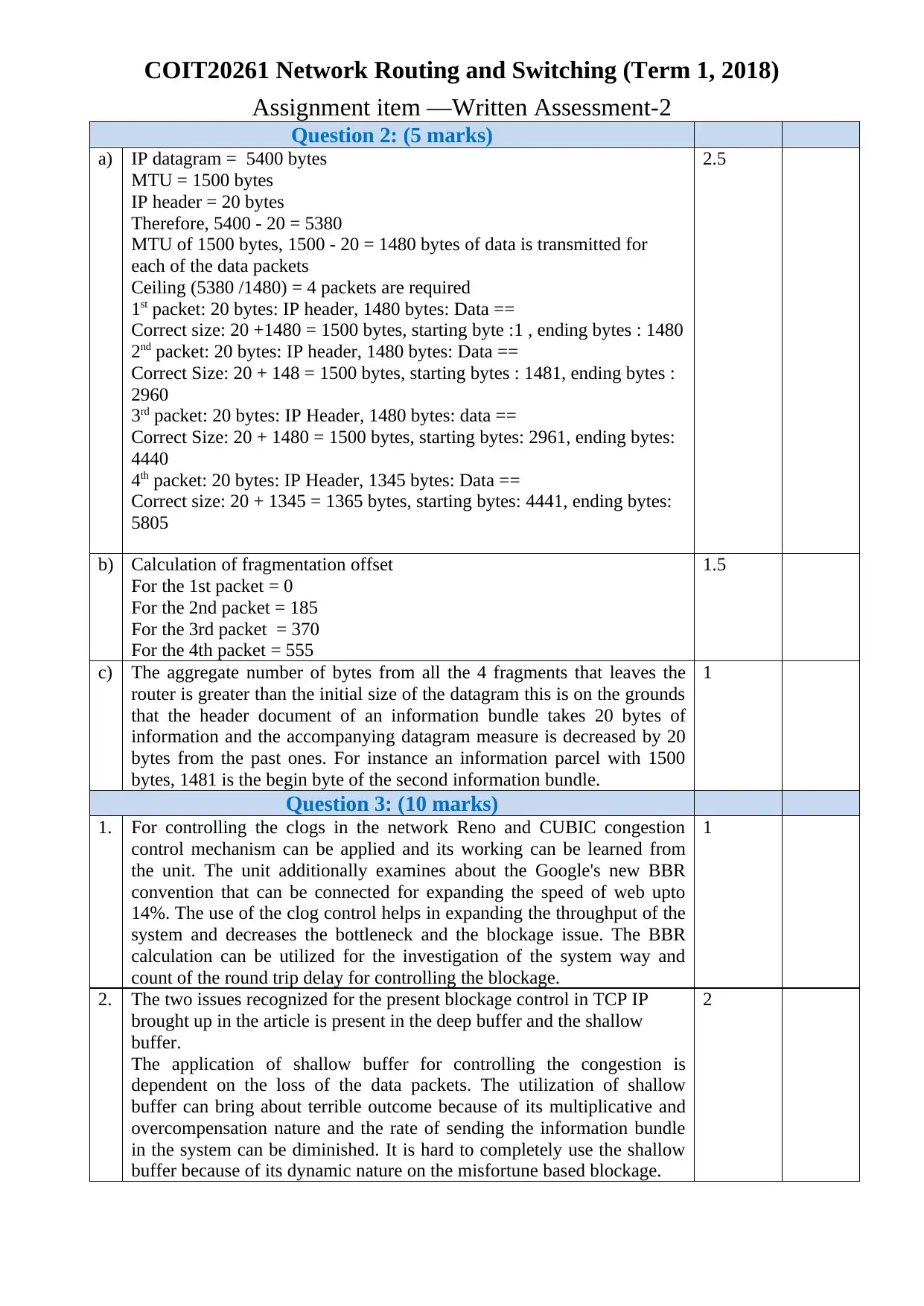
COIT20261 Network Routing and Switching (Term 1, 2018)
Assignment item —Written Assessment-2
Question 2: (5 marks)
a) IP datagram = 5400 bytes
MTU = 1500 bytes
IP header = 20 bytes
Therefore, 5400 - 20 = 5380
MTU of 1500 bytes, 1500 - 20 = 1480 bytes of data is transmitted for
each of the data packets
Ceiling (5380 /1480) = 4 packets are required
1st packet: 20 bytes: IP header, 1480 bytes: Data ==
Correct size: 20 +1480 = 1500 bytes, starting byte :1 , ending bytes : 1480
2nd packet: 20 bytes: IP header, 1480 bytes: Data ==
Correct Size: 20 + 148 = 1500 bytes, starting bytes : 1481, ending bytes :
2960
3rd packet: 20 bytes: IP Header, 1480 bytes: data ==
Correct Size: 20 + 1480 = 1500 bytes, starting bytes: 2961, ending bytes:
4440
4th packet: 20 bytes: IP Header, 1345 bytes: Data ==
Correct size: 20 + 1345 = 1365 bytes, starting bytes: 4441, ending bytes:
5805
2.5
b) Calculation of fragmentation offset
For the 1st packet = 0
For the 2nd packet = 185
For the 3rd packet = 370
For the 4th packet = 555
1.5
c) The aggregate number of bytes from all the 4 fragments that leaves the
router is greater than the initial size of the datagram this is on the grounds
that the header document of an information bundle takes 20 bytes of
information and the accompanying datagram measure is decreased by 20
bytes from the past ones. For instance an information parcel with 1500
bytes, 1481 is the begin byte of the second information bundle.
1
Question 3: (10 marks)
1. For controlling the clogs in the network Reno and CUBIC congestion
control mechanism can be applied and its working can be learned from
the unit. The unit additionally examines about the Google's new BBR
convention that can be connected for expanding the speed of web upto
14%. The use of the clog control helps in expanding the throughput of the
system and decreases the bottleneck and the blockage issue. The BBR
calculation can be utilized for the investigation of the system way and
count of the round trip delay for controlling the blockage.
1
2. The two issues recognized for the present blockage control in TCP IP
brought up in the article is present in the deep buffer and the shallow
buffer.
The application of shallow buffer for controlling the congestion is
dependent on the loss of the data packets. The utilization of shallow
buffer can bring about terrible outcome because of its multiplicative and
overcompensation nature and the rate of sending the information bundle
in the system can be diminished. It is hard to completely use the shallow
buffer because of its dynamic nature on the misfortune based blockage.
2
Assignment item —Written Assessment-2
Question 2: (5 marks)
a) IP datagram = 5400 bytes
MTU = 1500 bytes
IP header = 20 bytes
Therefore, 5400 - 20 = 5380
MTU of 1500 bytes, 1500 - 20 = 1480 bytes of data is transmitted for
each of the data packets
Ceiling (5380 /1480) = 4 packets are required
1st packet: 20 bytes: IP header, 1480 bytes: Data ==
Correct size: 20 +1480 = 1500 bytes, starting byte :1 , ending bytes : 1480
2nd packet: 20 bytes: IP header, 1480 bytes: Data ==
Correct Size: 20 + 148 = 1500 bytes, starting bytes : 1481, ending bytes :
2960
3rd packet: 20 bytes: IP Header, 1480 bytes: data ==
Correct Size: 20 + 1480 = 1500 bytes, starting bytes: 2961, ending bytes:
4440
4th packet: 20 bytes: IP Header, 1345 bytes: Data ==
Correct size: 20 + 1345 = 1365 bytes, starting bytes: 4441, ending bytes:
5805
2.5
b) Calculation of fragmentation offset
For the 1st packet = 0
For the 2nd packet = 185
For the 3rd packet = 370
For the 4th packet = 555
1.5
c) The aggregate number of bytes from all the 4 fragments that leaves the
router is greater than the initial size of the datagram this is on the grounds
that the header document of an information bundle takes 20 bytes of
information and the accompanying datagram measure is decreased by 20
bytes from the past ones. For instance an information parcel with 1500
bytes, 1481 is the begin byte of the second information bundle.
1
Question 3: (10 marks)
1. For controlling the clogs in the network Reno and CUBIC congestion
control mechanism can be applied and its working can be learned from
the unit. The unit additionally examines about the Google's new BBR
convention that can be connected for expanding the speed of web upto
14%. The use of the clog control helps in expanding the throughput of the
system and decreases the bottleneck and the blockage issue. The BBR
calculation can be utilized for the investigation of the system way and
count of the round trip delay for controlling the blockage.
1
2. The two issues recognized for the present blockage control in TCP IP
brought up in the article is present in the deep buffer and the shallow
buffer.
The application of shallow buffer for controlling the congestion is
dependent on the loss of the data packets. The utilization of shallow
buffer can bring about terrible outcome because of its multiplicative and
overcompensation nature and the rate of sending the information bundle
in the system can be diminished. It is hard to completely use the shallow
buffer because of its dynamic nature on the misfortune based blockage.
2
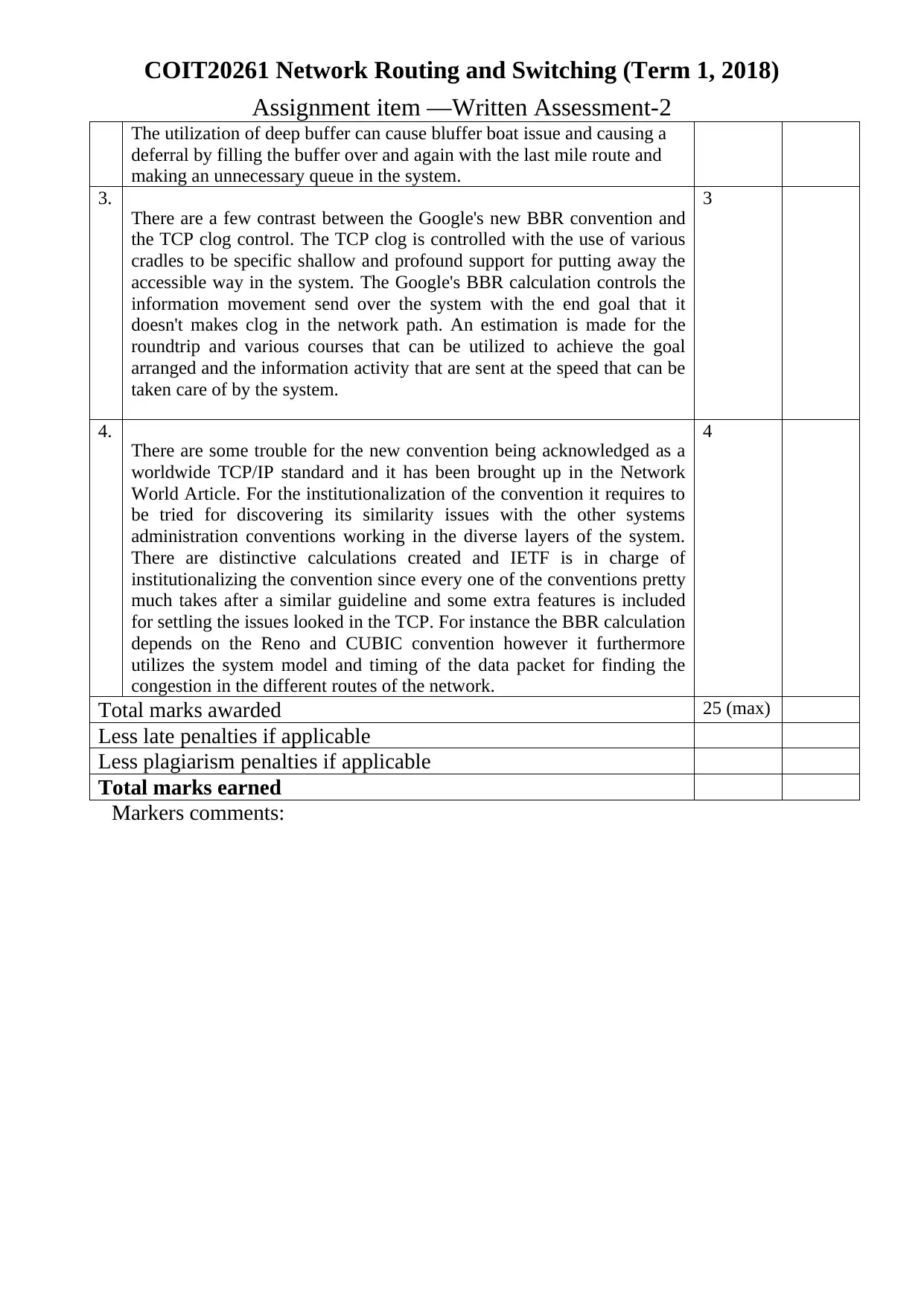
COIT20261 Network Routing and Switching (Term 1, 2018)
Assignment item —Written Assessment-2
The utilization of deep buffer can cause bluffer boat issue and causing a
deferral by filling the buffer over and again with the last mile route and
making an unnecessary queue in the system.
3.
There are a few contrast between the Google's new BBR convention and
the TCP clog control. The TCP clog is controlled with the use of various
cradles to be specific shallow and profound support for putting away the
accessible way in the system. The Google's BBR calculation controls the
information movement send over the system with the end goal that it
doesn't makes clog in the network path. An estimation is made for the
roundtrip and various courses that can be utilized to achieve the goal
arranged and the information activity that are sent at the speed that can be
taken care of by the system.
3
4.
There are some trouble for the new convention being acknowledged as a
worldwide TCP/IP standard and it has been brought up in the Network
World Article. For the institutionalization of the convention it requires to
be tried for discovering its similarity issues with the other systems
administration conventions working in the diverse layers of the system.
There are distinctive calculations created and IETF is in charge of
institutionalizing the convention since every one of the conventions pretty
much takes after a similar guideline and some extra features is included
for settling the issues looked in the TCP. For instance the BBR calculation
depends on the Reno and CUBIC convention however it furthermore
utilizes the system model and timing of the data packet for finding the
congestion in the different routes of the network.
4
Total marks awarded 25 (max)
Less late penalties if applicable
Less plagiarism penalties if applicable
Total marks earned
Markers comments:
Assignment item —Written Assessment-2
The utilization of deep buffer can cause bluffer boat issue and causing a
deferral by filling the buffer over and again with the last mile route and
making an unnecessary queue in the system.
3.
There are a few contrast between the Google's new BBR convention and
the TCP clog control. The TCP clog is controlled with the use of various
cradles to be specific shallow and profound support for putting away the
accessible way in the system. The Google's BBR calculation controls the
information movement send over the system with the end goal that it
doesn't makes clog in the network path. An estimation is made for the
roundtrip and various courses that can be utilized to achieve the goal
arranged and the information activity that are sent at the speed that can be
taken care of by the system.
3
4.
There are some trouble for the new convention being acknowledged as a
worldwide TCP/IP standard and it has been brought up in the Network
World Article. For the institutionalization of the convention it requires to
be tried for discovering its similarity issues with the other systems
administration conventions working in the diverse layers of the system.
There are distinctive calculations created and IETF is in charge of
institutionalizing the convention since every one of the conventions pretty
much takes after a similar guideline and some extra features is included
for settling the issues looked in the TCP. For instance the BBR calculation
depends on the Reno and CUBIC convention however it furthermore
utilizes the system model and timing of the data packet for finding the
congestion in the different routes of the network.
4
Total marks awarded 25 (max)
Less late penalties if applicable
Less plagiarism penalties if applicable
Total marks earned
Markers comments:
Paraphrase This Document
Need a fresh take? Get an instant paraphrase of this document with our AI Paraphraser
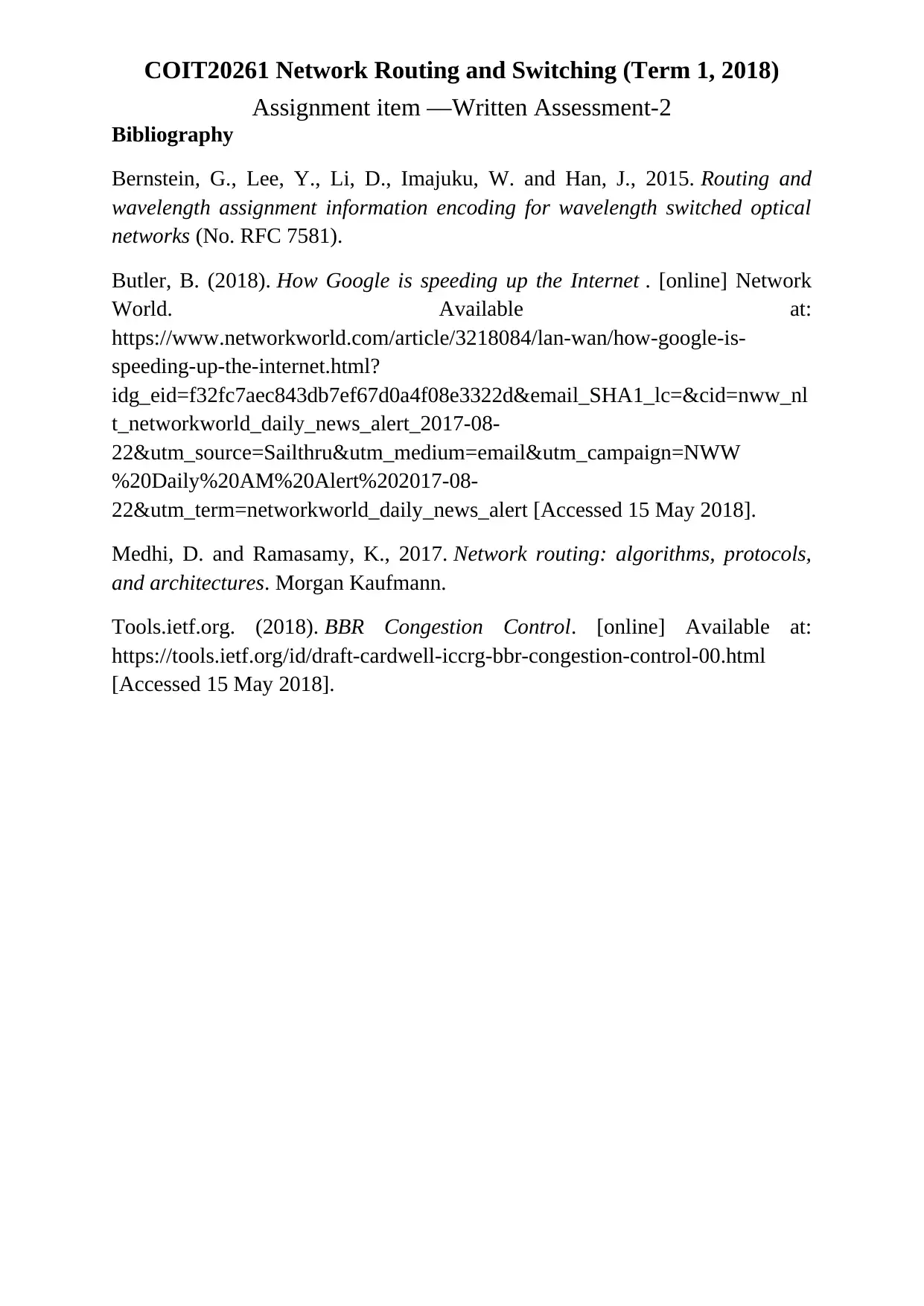
COIT20261 Network Routing and Switching (Term 1, 2018)
Assignment item —Written Assessment-2
Bibliography
Bernstein, G., Lee, Y., Li, D., Imajuku, W. and Han, J., 2015. Routing and
wavelength assignment information encoding for wavelength switched optical
networks (No. RFC 7581).
Butler, B. (2018). How Google is speeding up the Internet . [online] Network
World. Available at:
https://www.networkworld.com/article/3218084/lan-wan/how-google-is-
speeding-up-the-internet.html?
idg_eid=f32fc7aec843db7ef67d0a4f08e3322d&email_SHA1_lc=&cid=nww_nl
t_networkworld_daily_news_alert_2017-08-
22&utm_source=Sailthru&utm_medium=email&utm_campaign=NWW
%20Daily%20AM%20Alert%202017-08-
22&utm_term=networkworld_daily_news_alert [Accessed 15 May 2018].
Medhi, D. and Ramasamy, K., 2017. Network routing: algorithms, protocols,
and architectures. Morgan Kaufmann.
Tools.ietf.org. (2018). BBR Congestion Control. [online] Available at:
https://tools.ietf.org/id/draft-cardwell-iccrg-bbr-congestion-control-00.html
[Accessed 15 May 2018].
Assignment item —Written Assessment-2
Bibliography
Bernstein, G., Lee, Y., Li, D., Imajuku, W. and Han, J., 2015. Routing and
wavelength assignment information encoding for wavelength switched optical
networks (No. RFC 7581).
Butler, B. (2018). How Google is speeding up the Internet . [online] Network
World. Available at:
https://www.networkworld.com/article/3218084/lan-wan/how-google-is-
speeding-up-the-internet.html?
idg_eid=f32fc7aec843db7ef67d0a4f08e3322d&email_SHA1_lc=&cid=nww_nl
t_networkworld_daily_news_alert_2017-08-
22&utm_source=Sailthru&utm_medium=email&utm_campaign=NWW
%20Daily%20AM%20Alert%202017-08-
22&utm_term=networkworld_daily_news_alert [Accessed 15 May 2018].
Medhi, D. and Ramasamy, K., 2017. Network routing: algorithms, protocols,
and architectures. Morgan Kaufmann.
Tools.ietf.org. (2018). BBR Congestion Control. [online] Available at:
https://tools.ietf.org/id/draft-cardwell-iccrg-bbr-congestion-control-00.html
[Accessed 15 May 2018].
1 out of 8
Related Documents
Your All-in-One AI-Powered Toolkit for Academic Success.
+13062052269
info@desklib.com
Available 24*7 on WhatsApp / Email
![[object Object]](/_next/static/media/star-bottom.7253800d.svg)
Unlock your academic potential
© 2024 | Zucol Services PVT LTD | All rights reserved.





